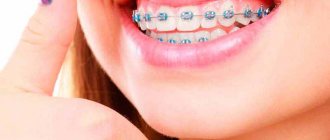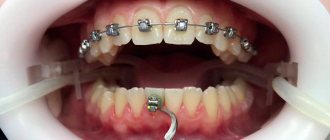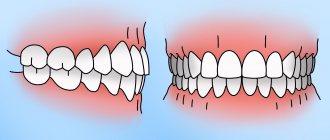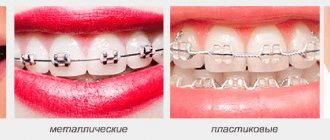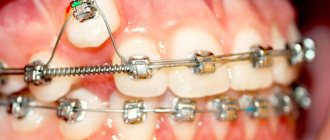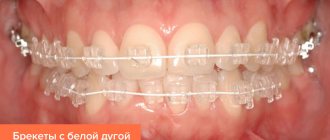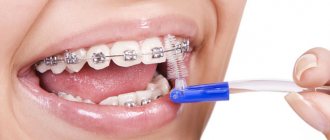Not every patient knows what a combined bracket system is. As a rule, treatment with braces is presented within the framework of the choice of one type of structure. Now you can learn in detail about the combined braces system and, perhaps, reconsider your views on correcting your bite.
A certain percentage of people consider these designs to be optimal for correcting occlusion in terms of price, quality and aesthetics. Speaking about the latter, one cannot help but notice that most often patients try to hide the presence of braces on their teeth as much as possible, sometimes agreeing to lingual braces, which cause a number of serious difficulties in everyday life.
Surely you know that braces are made from different materials. Each of them has a different impact on teeth, strength and appearance. Materials and prices vary. Most often you have to choose between the effectiveness of the treatment and the beauty of your smile, even during treatment. But how to combine the invisibility of transparent braces and the effectiveness of metal ones? More on this later.
Combined braces: indications for installation
Combined braces are selected according to indications:
- Finding a compromise between aesthetics and functionality. It has been proven that metal braces guarantee the maximum effectiveness of treatment, but they are the most unaesthetic and stand out on the teeth. In order not to spoil the beauty of a smile with metal locks, doctors select a different type of brace system for the front teeth, leaving metal for invisible areas.
- Selection for malocclusion pathology. Often, only one jaw needs strong correction—the upper or lower. The second requires less intensive treatment. In this case, doctors recommend installing different orthodontic systems on the upper and lower teeth, which allows you to combine materials or types of devices.
- Patients' financial wishes. Metal structures are not only the most effective, but also inexpensive. Sapphire and lingual braces cost significant amounts. Combining options allows you to save money, get an aesthetically pleasing result during the correction period, and achieve bite correction in a short time.
If we consider strictly the medical indications for installing combined braces, then among them will be:
- pathological bite - open, distal, mesial, deep;
- disproportionate development of the jaws;
- diastemas, trema, large interdental spaces;
- dystopia, incorrect position of individual teeth in the jaw.
Unpleasant moments after installation
Despite all the advantages of such braces, they, like all other orthodontic structures, involve some unpleasant moments after installation.
Almost everyone who has ever been interested in the possibility of getting straight teeth knows about this today. During the consultation, the doctor will once again remind the patient about possible inconveniences during bite correction. Almost everyone experiences discomfort in the first days and weeks after installation. This is due to the unusual constant load and pressure on the teeth that braces exert. Therefore, there is no need to be afraid of an unpleasant moment: the discomfort will pass on its own.
There is also a risk of inflammation of the mucous membrane upon contact with braces and friction, but this can also be solved. Problems with diction are also easy to fix. In general, after a month, all patients get used to braces and stop noticing them.
Combined braces: metal-ceramics and other types
In the photo, combined braces are a combination of metal with ceramics or sapphire clasps. In fact, there are very different combinations. The most popular and in demand among patients:
- Combined metal and ceramic braces. According to pediatric dentists, the optimal combination of materials. Ceramics do not withstand heavy loads well, which justifies its use for front teeth. Metal braces do an excellent job of basic correction, quickly and accurately correcting the bite.
- Combined bracket system made of metal and sapphires. More expensive than the previous option, but even more aesthetically pleasing and comfortable. Sapphires have the ability to adapt to the color of tooth enamel, which makes braces virtually invisible on patients' teeth.
- A combination of the vestibular and lingual systems, which allows you to make bite correction invisible to others. Internal braces are placed on the teeth of the upper jaw row, and metal classics are attached to the lower ones.
Braces for lower teeth: prices in Moscow
The cost of orthodontic treatment depends on several points:
- The chosen system is ligature or self-ligating, lingual braces or vestibular.
- The material of the braces is metal, sapphire, ceramic. The most inexpensive are vestibular metal ligatures. They are recommended by doctors for local correction of lower teeth.
- Manufacturer company. Clarity Advanced braces, as well as many other brands, have received good reviews.
- Scope of preparatory work – treatment of caries of permanent teeth, professional hygiene.
- X-ray studies.
The range and final amount of treatment can be calculated by the doctor after conducting the necessary examinations and assessing the pathology of the bite.
Azabuka Children's Dental Clinic offers bite correction services and finds a solution to eliminate any anomalies. The clinic's orthodontists will select an orthodontic system for any patient - plates, aligners, braces - will help restore the health and beauty of teeth.
Why do people come to the Aza&Buka clinic for combined braces?
The installation of combined brace systems has nuances and requires maximum professionalism from orthodontists. Pediatric dentistry Aza&Buka is:
- The work of experienced doctors. Patients are treated by orthodontists of the highest category who have experience working with various materials, systems, and devices.
- Excellent diagnostics and proven treatment regimens. Doctors select combinations of braces taking into account the existing bite pathology, combining the functionality and aesthetics of different materials.
- Selection of orthodontic appliances. The dental clinic offers braces from the best manufacturers - metal, ceramic, sapphire, lingual, vestibular.
Metal braces: photos “before” and “after” treatment
Orthodontists document manipulations in medical records and using a dental photo protocol. The doctor uses photographs to plan and illustrate treatment progress. After the patient has signed consent to the processing of personal data and allowed the photographs to be used for commercial purposes, the orthodontist has the right to post the photo protocol on the Internet.
photo protocol for deep bite treatment
Orthodontists publish “before” and “after” photos of braces treatment on social networks to attract new patients, show the quality of treatment and discuss clinical cases with colleagues.
Installation of combined braces: stages
Combining braces require a careful approach when treating malocclusion. The correction takes place in several stages:
- Diagnostics
The patient is given CT, OPTG, and TRG images, which guarantees the opportunity to study the structure of the jaws in different projections - to determine the type of pathology and prepare a treatment strategy.
- Taking impressions
Impressions of the patient's dentition are intended to create a diagnostic model and carry out calculations.
- Oral preparation
The patient is treated for all teeth - caries, pulpitis. They also perform professional hygiene to remove plaque and mineral deposits.
- Fixing braces
The doctor attaches braces to the teeth one by one according to the agreed pattern. Usually, aesthetic, inconspicuous plates are placed on the upper teeth, from canine to canine, and metal plates are placed on the upper and lower lateral teeth. Sometimes sapphire and ceramic braces are glued to 12 teeth - to the frontal areas of both jaws.
- Treatment control
Planned appointments are carried out every month - to replace ligatures, orthodontic power arches, and install elastics. And also to check the effectiveness of the correction.
- Retention period
After removing the combined braces, the patient wears retainers, special arches installed behind the 6 front teeth. The task of retainers is to record the result of treatment.
Indications for use
- A compromise between functionality and aesthetics.
In case of significant curvature of the dentition, metal braces are recommended for the most effective treatment, but not everyone is ready to wear them. In this case, you can find a compromise between beauty and benefit by installing different types of systems (according to functional and aesthetic indicators) for the anterior and chewing teeth. - Each jaw has its own braces.
The case when different types of devices are used to correct the bite on different jaws. This is especially true if the lower dentition is more crooked than the upper one, and wearing metal braces is recommended to correct it. And you can safely install a more aesthetic design on your upper teeth. - Financial question.
Metal structures are often recommended for serious anomalies, but bite correction can be successfully corrected using any system. But whether there is enough money for, say, sapphire braces is a big question. In conditions of limited budget, combined systems can serve very well.
Answers to popular questions
What are the “disadvantages” of combined braces?
Combined braces require a little more careful care, as well as careful wearing, since ceramics and sapphires are quite fragile materials. There are no more cons.
Do ligature and self-ligating braces combine?
Yes, but rarely, since there are no special indications for combining systems.
Why don't all orthodontists agree to combine braces?
Connecting different brace systems requires experience and professionalism from the doctor. It also takes longer to install. Aza&Buka dentistry practices the installation of combined braces according to indications and with the consent of the patient.
Why do they put transparent ones in front and metal ones on the sides?
This is justified aesthetically and functionally. The most inconspicuous materials are used in the smile area, and the most effective metal braces work to move molars and premolars.
Can combined braces be used only on the upper teeth?
Yes, sure. In this case, the doctor will place metal braces on the lower jaw.
Did not find an answer to your question?
Common bite pathologies
To understand why you cannot insist on local correction of the bite, it is worth getting acquainted with the main deviations in jaw closure. The description of pathologies shows that correction should be carried out comprehensively. Otherwise, treatment will only worsen the problem, even if there are no visible prerequisites for this.
To diagnose a bite, doctors rely on photographs of the jaws - a comprehensive x-ray examination:
- OPTG (orthopantomogram) – a panoramic image of the dentofacial rows;
- CT – computed tomography of one or two jaws;
- TRG (teleradiogram) – lateral projection of the skull.
The most common malocclusions:
- Open – when the jaws are closed, there is no contact in the frontal zone or in the area of the chewing teeth.
- Deep - the lower incisors overlap the upper antagonist teeth by more than a third.
- Distal – the upper row of teeth is pushed forward.
- Mesial – the lower jaw protrudes forward.
- Crossed - the jaw rows are changed in shape or size in the horizontal direction.
Any pathology requires complex correction, since with partial displacement of teeth, the existing disproportion will only intensify. Moreover, with almost correct closure of the jaws, movements of the lower teeth can provoke a violation of occlusion - displace the cutting edges or chewing surfaces of individual units relative to each other. Visually, the teeth will become straight, but the bite will be disrupted.
Soldatenkova Alina
It is impossible to immediately say what orthodontic treatment is indicated for the patient. Just guess. A constructive dialogue begins after receiving x-rays, where you can see not just the current picture, but also hidden processes - impacted and dystopic teeth, the condition of the roots and periodontal tissues. After studying the images and OPTG, we can discuss the installation of braces on the lower jaw or another treatment option.
Why combine braces?
Ceramic or transparent products are installed on the front group of teeth, and metal ones are installed on the sides as a base. The choice of such a combination ensures the strength of the structure under heavy chewing loads and high results in correcting defects. The main task of combining braces will allow patients not to pay for beauty where it is not so important. Aesthetic products are needed in the smile area so that a person does not experience discomfort during the treatment period, but on the side, reliability is more important. In this way, it is possible to simultaneously ensure high levels of functionality of the system, reduce the time of wearing braces, the time of correction and preserve the aesthetics of the dentition.
There are no transparent arcs that would be invisible; classic metal arcs are inserted into sapphire and ceramic systems. They are slightly visible, but do not create the effect of metal staples. To improve their aesthetics, you can use coated arcs, the material of which is similar to Teflon. But there is a minus - the coating can wear off due to friction.
Braces care
To prevent tooth decay and dark spots on your teeth, you should maintain good oral hygiene during treatment. After each meal, you need to brush your teeth with a special orthodontic brush. “Brushes” are used to clean the interdental spaces, clasps and the space between the teeth and the arch. In addition, you will have to forget about eating too hard and viscous foods: nuts, caramel, chewing gum, chocolates. If the system uses plastic braces, then it is necessary to exclude coloring food and drinks.
Prices
| View | Set for one jaw | Installation | Installment plan |
| Metal | from 30,000 rub. | from 20,000 rub. | 7,000 - 9,000 rub./month |
| Sapphire | from 50,000 rub. | from 30,000 rub. | 10,000 rub./month |
| Ceramic | from 45,000 rub. | from 30,000 rub. | 10,000 rub./month |
| Plastic | from 40,000 rub. | from 30,000 rub. | 10,000 rub./month |
| Other types | from 40,000 rub. | from 30,000 rub. | 10,000 rub./month |
How long do you wear braces?
How long braces are worn will primarily depend on the degree of curvature of the dentition. The duration of bite correction with braces in children will be on average from 1.5 to 2 years (with minor changes in the bite - about 1 year), but in adults - on average from 2.5 to 3 years. However, the duration of treatment depends not only on the curvature of the teeth, but also on the qualifications/experience of the orthodontist, as well as on the characteristics of the brace system you choose.
For example, if you install self-ligating braces (in which the metal arch is fixed not by ligatures, but by micro-locks), the treatment will almost always last longer. This is due to the fact that self-ligating braces only have passive ligation of the metal arch and there is no ability to switch the type of ligation from active to passive, and vice versa. This means that treatment at some stage may simply stall.
In addition, when choosing self-ligating ceramic braces, the treatment will be even longer, because the archwire fixation system in the form of ceramic micro-locks on the surface of the braces is a priori less reliable. Therefore, to avoid micro-locks breaking, orthodontists usually use “less force” tactics. This means that the teeth will experience less stress, and therefore their movement will take longer. But the slowest rate of tooth movement will certainly be with lingual braces (the so-called “invisible braces”).
Important: the movement of teeth in the bone tissue of the jaws (when wearing braces) a priori cannot be a quick process. The fact is that tooth movement occurs due to the process of “bone remodeling” around the roots of the teeth being moved. This process consists of parallel resorption of bone in the direction of movement of the tooth root, and its formation behind the direction of movement of the tooth root. That is why the treatment takes a long time.
Features of installing braces in adults, adolescents and children
Installing braces for a teenager is not much different from installing braces for an adult.
Correcting the bite in children simply happens faster. The need for treatment with braces and the appropriate age will be determined by the orthodontist. For a teenager, the cost of braces in Moscow depends on the clinic and the chosen design. Braces are not used on baby teeth. If they are placed too early, the child may be left without teeth. To install braces, you will have to wait at least 10 to 12 years until your teeth change. The age after 14 years is optimal for using braces. Treatment occurs faster than in adults and is easier to tolerate.
Parents often doubt whether teenagers should get braces. Crooked teeth can lead to health problems over time. Incorrect positioning of teeth provokes the development of caries, periodontitis, and digestive problems.
How do braces work?
Correction of defects in the dentition occurs due to pressure on incorrectly located units. The system consists of passive and active elements. The first include locks that are installed on each tooth using dental material. It provides reliable bonding without negatively affecting the enamel. Each lock has a groove for an arc.
The active element in the system is a metal arc that passes through the grooves of the locks, creating a solid structure. It has a unique property - to return to its original position, no matter how bent it is. Before installation, it has the correct shape, which it should take after the end of treatment. Under the influence of its force, the dentition moves in the desired direction, occupying the correct position.
Advantages
The advantages of combined Damon Clear and Damon Q braces include:
- high rates of correction efficiency;
- high aesthetics;
- food coloring resistant, no pigmentation or darkening;
- low coefficient of friction between tooth enamel and structural elements;
- precise fixation, treatment control;
- patented fastening of individual components of the Spin Tek device;
- made from medical steel, durable and corrosion-resistant;
- there is no aftertaste, diction or speech problems when worn;
- The correction procedure is simple and does not take much time;
- soft tissues and enamel are not injured when worn;
- alignment of the row occurs naturally;
- uniform load distribution.
